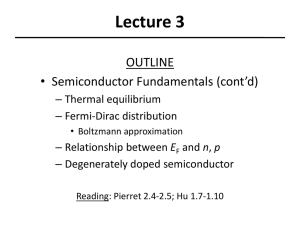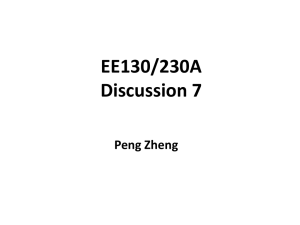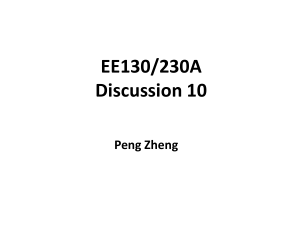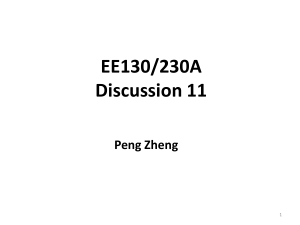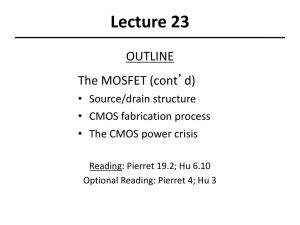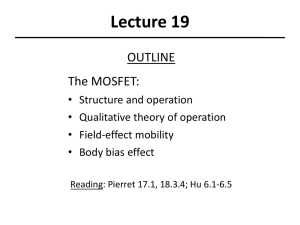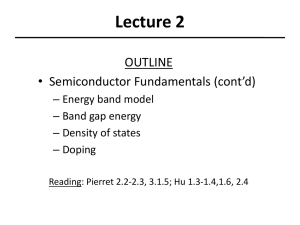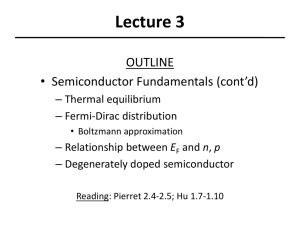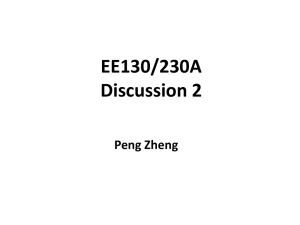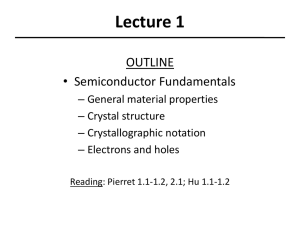Lecture3marked
advertisement
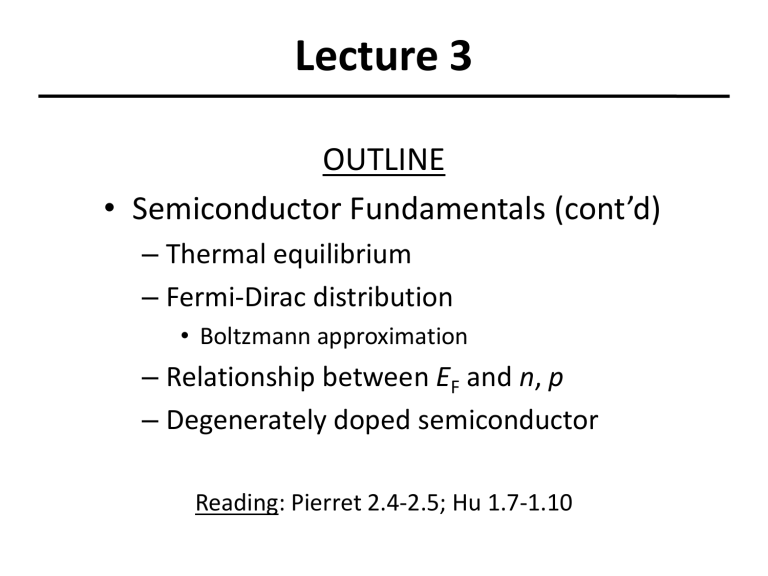
Lecture 3 OUTLINE • Semiconductor Fundamentals (cont’d) – Thermal equilibrium – Fermi-Dirac distribution • Boltzmann approximation – Relationship between EF and n, p – Degenerately doped semiconductor Reading: Pierret 2.4-2.5; Hu 1.7-1.10 Fluid Analogy Conduction Band Valence Band EE130/230A Fall 2013 Lecture 3, Slide 2 Thermal Equilibrium • No external forces are applied: – electric field = 0, magnetic field = 0 – mechanical stress = 0 – no light • Dynamic situation in which every process is balanced by its inverse process Electron-hole pair (EHP) generation rate = EHP recombination rate • Thermal agitation electrons and holes exchange energy with the crystal lattice and each other Every energy state in the conduction band and valence band has a certain probability of being occupied by an electron EE130/230A Fall 2013 Lecture 3, Slide 3 Analogy for Thermal Equilibrium Sand particles C. C. Hu, Modern Semiconductor Devices for Integrated Circuits, Figure 1-17 • There is a certain probability for the electrons in the conduction band to occupy high-energy states under the agitation of thermal energy (vibrating atoms). EE130/230A Fall 2013 Lecture 3, Slide 4 Fermi Function • Probability that an available state at energy E is occupied: f (E) 1 1 e ( E E F ) / kT • EF is called the Fermi energy or the Fermi level There is only one Fermi level in a system at equilibrium. If E >> EF : If E << EF : If E = EF : EE130/230A Fall 2013 Lecture 3, Slide 5 Effect of Temperature on f(E) EE130/230A Fall 2013 Lecture 3, Slide 6 Boltzmann Approximation If E EF 3kT , f ( E ) e ( E EF ) / kT If EF E 3kT , f ( E ) 1 e ( E EF ) / kT Probability that a state is empty (i.e. occupied by a hole): 1 f (E) e EE130/230A Fall 2013 ( E EF ) / kT Lecture 3, Slide 7 e ( EF E ) / kT Equilibrium Distribution of Carriers • Obtain n(E) by multiplying gc(E) and f(E) Energy band diagram EE130/230A Fall 2013 Density of States, gc(E) × Probability of occupancy, f(E) Lecture 3, Slide 8 cnx.org/content/m13458/latest = Carrier distribution, n(E) • Obtain p(E) by multiplying gv(E) and 1-f(E) Energy band diagram EE130/230A Fall 2013 Density of States, gv(E) × Probability of occupancy, 1-f(E) Lecture 3, Slide 9 = cnx.org/content/m13458/latest Carrier distribution, p(E) Equilibrium Carrier Concentrations • Integrate n(E) over all the energies in the conduction band to obtain n: n top of conductionband Ec g c(E)f(E)dE • By using the Boltzmann approximation, and extending the integration limit to , we obtain 3/ 2 * 2mn , DOS kT ( Ec E F ) / kT n Nce where N c 2 2 h EE130/230A Fall 2013 Lecture 3, Slide 10 • Integrate p(E) over all the energies in the valence band to obtain p: p Ev bottomof valence band gv(E)1 f(E)dE • By using the Boltzmann approximation, and extending the integration limit to -, we obtain p Nve EE130/230A Fall 2013 ( E F Ev ) / kT 2m where N v 2 h * p , DOS 2 Lecture 3, Slide 11 kT 3/ 2 Intrinsic Carrier Concentration np N c e ( Ec EF ) / kT N e ( EF Ev ) / kT v Nc Nve ( Ec Ev ) / kT Nc Nve ni N c N v e EG / kT n EG / 2 kT Effective Densities of States at the Band Edges (@ 300K) Si Ge GaAs Nc (cm-3) 2.82 × 1019 1.05 × 1019 4.37 × 1017 Nv (cm-3) EE130/230A Fall 2013 1.83 × 1019 3.92 × 1018 Lecture 3, Slide 12 8.12 × 1018 2 i n(ni, Ei) and p(ni, Ei) • In an intrinsic semiconductor, n = p = ni and EF = Ei n ni N c e ( Ec Ei ) / kT N c ni e( Ec Ei ) / kT n ni e EE130/230A Fall 2013 p ni N v e ( Ei Ev ) / kT N v ni e( Ei Ev ) / kT ( E F Ei ) / kT Lecture 3, Slide 13 p ni e ( Ei E F ) / kT Intrinsic Fermi Level, Ei • To find EF for an intrinsic semiconductor, use the fact that n = p: Nce ( Ec E F ) / kT Nve ( E F Ev ) / kT Ec Ev kT N v EF ln Ei 2 2 Nc * m Ec Ev 3kT p , DOS Ec Ev Ei ln * 2 4 mn , DOS 2 EE130/230A Fall 2013 Lecture 3, Slide 14 n-type Material R. F. Pierret, Semiconductor Device Fundamentals, Figure 2.16 Energy band diagram EE130/230A Fall 2013 Density of States Probability of occupancy Lecture 3, Slide 15 Carrier distributions Example: Energy-band diagram Question: Where is EF for n = 1017 cm-3 (at 300 K) ? EE130/230A Fall 2013 Lecture 3, Slide 16 Example: Dopant Ionization Consider a phosphorus-doped Si sample at 300K with ND = 1017 cm-3. What fraction of the donors are not ionized? Hint: Suppose at first that all of the donor atoms are ionized. Nc EF Ec kT ln Ec 147meV n Probability of non-ionization 1 1 e ( ED EF ) / kT 1 0.02 (147meV 45meV ) / 26 meV 1 e EE130/230A Fall 2013 Lecture 3, Slide 17 p-type Material R. F. Pierret, Semiconductor Device Fundamentals, Figure 2.16 Energy band diagram EE130/230A Fall 2013 Density of States Probability of occupancy Lecture 3, Slide 18 Carrier distributions Non-degenerately Doped Semiconductor • Recall that the expressions for n and p were derived using the Boltzmann approximation, i.e. we assumed Ev 3kT EF Ec 3kT Ec 3kT EF in this range 3kT Ev The semiconductor is said to be non-degenerately doped in this case. EE130/230A Fall 2013 Lecture 3, Slide 19 Degenerately Doped Semiconductor • If a semiconductor is very heavily doped, the Boltzmann approximation is not valid. In Si at T=300K: Ec-EF < 3kBT if ND > 1.6x1018 cm-3 EF-Ev < 3kBT if NA > 9.1x1017 cm-3 The semiconductor is said to be degenerately doped in this case. • Terminology: “n+” degenerately n-type doped. EF Ec “p+” degenerately p-type doped. EF Ev EE130/230A Fall 2013 Lecture 3, Slide 20 Band Gap Narrowing • If the dopant concentration is a significant fraction of the silicon atomic density, the energy-band structure is perturbed the band gap is reduced by DEG : R. J. Van Overstraeten and R. P. Mertens, Solid State Electronics vol. 30, 1987 8 DEG 3.5 10 N 1/ 3 300 T N = 1018 cm-3: DEG = 35 meV N = 1019 cm-3: DEG = 75 meV EE130/230A Fall 2013 Lecture 3, Slide 21 Dependence of EF on Temperature C. C. Hu, Modern Semiconductor Devices for Integrated Circuits, Figure 1-21 n N c e ( Ec EF ) / kT EF Ec kT ln N c n Net Dopant Concentration (cm-3) EE130/230A Fall 2013 Lecture 3, Slide 22 Summary • Thermal equilibrium: – Balance between internal processes with no external stimulus (no electric field, no light, etc.) – Fermi function f (E) 1 1 e ( E EF ) / kT • Probability that a state at energy E is filled with an electron, under equilibrium conditions. • Boltzmann approximation: For high E, i.e. E – EF > 3kT: f ( E ) e ( E EF ) / kT For low E, i.e. EF – E > 3kT: EE130/230A Fall 2013 Lecture 3, Slide 23 1 f ( E ) e ( EF E ) / kT Summary (cont’d) • Relationship between EF and n, p : n Nce ( Ec E F ) / kT p Nve ( E F Ev ) / kT ni e ( E F Ei ) / kT ni e ( Ei E F ) / kT • Intrinsic carrier concentration : ni N c N v e EG / 2 kT • The intrinsic Fermi level, Ei, is located near midgap. EE130/230A Fall 2013 Lecture 3, Slide 24 Summary (cont’d) • If the dopant concentration exceeds 1018 cm-3, silicon is said to be degenerately doped. – The simple formulas relating n and p exponentially to EF are not valid in this case. For degenerately doped n-type (n+) Si: EF Ec For degenerately doped p-type (p+) Si: EF Ev EE130/230A Fall 2013 Lecture 3, Slide 25

